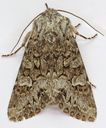Hodges#10311
Papestra biren
Classification
- Phylum: Arthropoda
- Subphylum: Hexapoda
- Class: Insecta
- Order: Lepidoptera
- Superfamily: Noctuoidea
- Family: Noctuidae
- Subfamily: Noctuinae
- Tribe: Hadenini
- Genus: Papestra
- Species: biren
Pronunciation
How to pronounce Papestra biren: //pəˈpɛstɹə ˈbaɪɹɛn//
These audio files are automatically generated. While they are not always 100% accurate, they are a good starting point.
Images






Summary
Papestra biren, known as the glaucous shears, is a moth of the family Noctuidae first described in 1781. This species is found across many regions in Europe and parts of Asia, including a North American introduction in Newfoundland. The larvae feed on specific low-growing mountain plants.
Physical Characteristics
Forewing length 15-17 mm; wingspan 30–38 mm; purplish grey forewing with blackish suffusion; hindwing dark brownish fuscous.
Identification Tips
Papestra biren can be identified by its purplish grey forewings, pale grey stigmata with black rims, and distinct submarginal lines.
Habitat
Boreal spruce-fir forests.
Distribution
Found in most of Europe (excluding southern Iberian Peninsula, Italy, and Greece), Kashmir, Palearctic region, Siberia, Central Asia, Amur, Kamchatka, the Russian Far East, Japan; introduced in Newfoundland.
Diet
Larvae primarily feed on Vaccinium uliginosum, Vaccinium myrtillus, and occasionally on Salix caprea and Sorbus aucuparia.
Life Cycle
Adults are on wing from May to July, with one generation per year.
Similar Taxa
Tags
- moth
- Noctuidae
- Papestra biren
- Lepidoptera